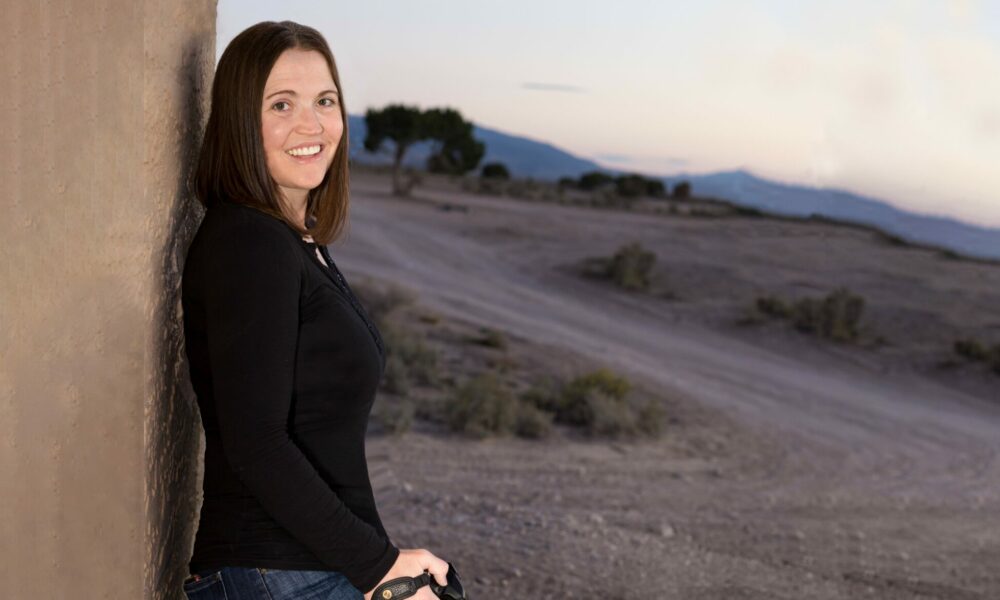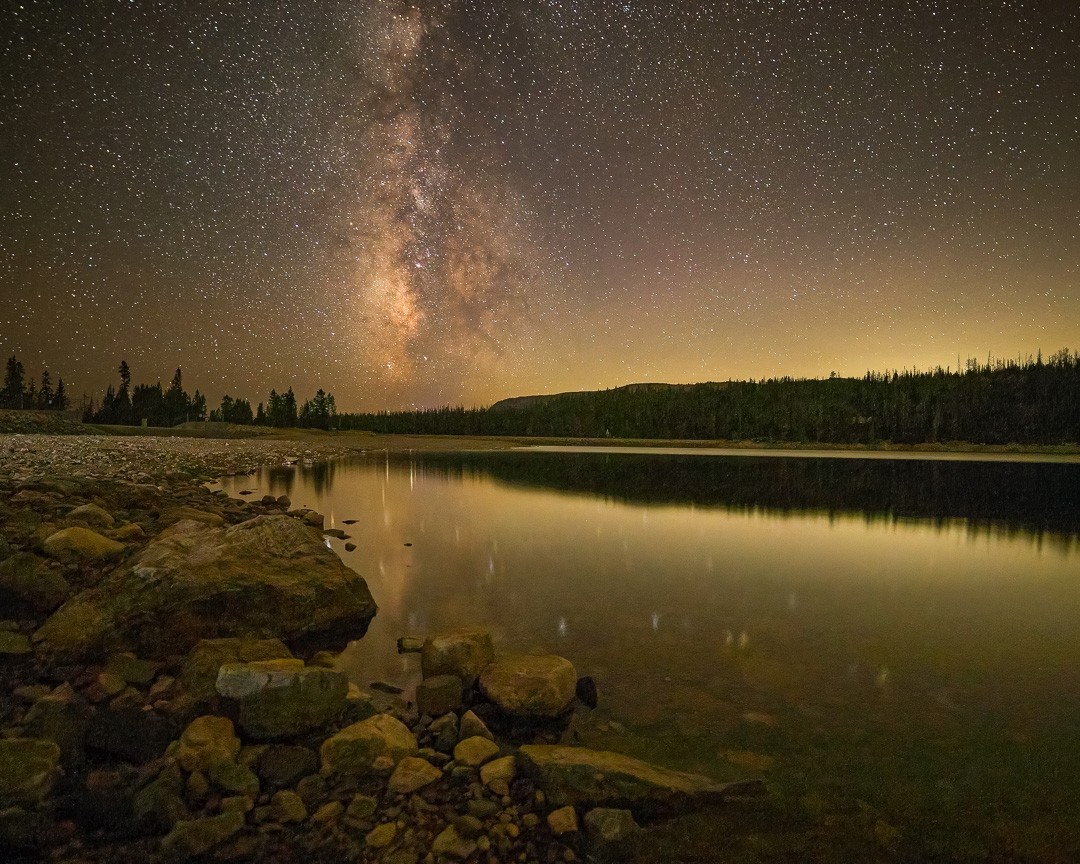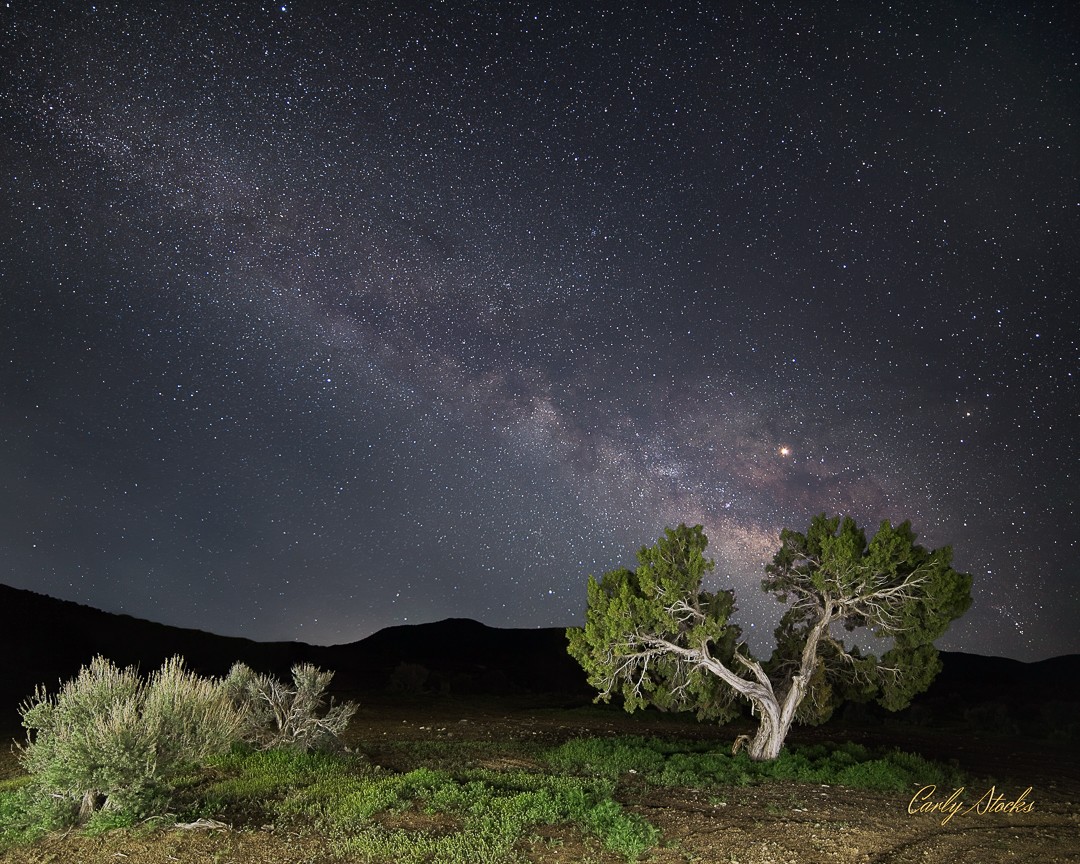

Today we’d like to introduce you to Carly Stocks.
Hi Carly, so excited to have you on the platform. So before we get into questions about your work-life, maybe you can bring our readers up to speed on your story and how you got to where you are today.
The feeling of being under a dark sky full of stars is what I try to capture in my images. I want the viewer to feel peace and connection to the world around them. In remote locations, one can truly experience silence and solitude. Wide open spaces and pristine night skies are some of Utah’s greatest treasures. I feel lucky each time I can capture, preserve, and share them.
My name is Carly Stocks, and I am a night sky photographer and educator. I have wanted to be a photographer since childhood, but I did not get the chance to pursue it until recently. When I pushed the shutter button for my first Milky Way photo, I did not realize I was embarking on a life-changing adventure.
I studied physics and history at university and wanted to become a teacher. Before student teaching, my main goal was to teach history, but I enjoyed the lab-based teaching style of my mentor physics teacher. He believed in using labs and hands-on experiences to make physics accessible for all students. The students loved his classes and learned so much. I wanted to become that kind of teacher.
After graduation, I started teaching physics full-time. I enjoyed helping students navigate and understand physics. I liked breaking down the processes and finding ways to explain concepts. My students worked hard, and we consistently led the district in state test scores. My experience teaching prepared me to understand the process of photography and gave me the skill set to share that knowledge with others.
I loved my time teaching physics, but when our first child was born, I took a break and stayed home full time. Like most new parents, I took a lot of pictures. I had been taking snapshots most of my life, but those old desires to learn photography and master my camera started to return. I read photography blogs and watched free tutorials when I had a chance. Slowly, I understood the basics, but I usually did not trust myself to take pictures off Auto mode.
While my main focus was learning to take good portraits, I always loved landscapes. Landscapes hold still for the most part. They do not roll their eyes or run away when you get your camera. While taking landscapes, you have time to try new settings.
My husband refurbished a 1950 trailer, and we camped nearly every weekend until the snow fell. Our camping trips allowed me to take more landscape photos. I made a lot of mistakes, but things were starting to make more sense. Around this time, I started following a few landscape photography Instagram accounts. One day, I came across some images of the Milky Way core. I thought they were beautiful. I never dreamed I could capture such things.
One day, I read a chapter on night photography in the book How to Create Stunning Digital Photography by Tony and Chelsea Northrup. The idea of night photography intrigued me because it seemed unique. I decided to try some light painting on our next camping trip. I also tried to take a few night landscapes with stars in the background. I enjoyed my first night photography session but did not plan on it being a regular thing. I am not sure it would have, had our little trailer had room for a bathroom.
The next time we went camping, my son had a bad dream and woke me up. After getting him back to sleep, I had to trek outside to use the facilities. The night was clear, and the stars were shining brightly. The sky was so beautiful. I wanted to try to get a picture of it. So I snuck back into the trailer to get my camera, jacket, and tripod. I took pictures for about an hour and was about to come in when I looked at the sky and saw something familiar.
I did not even know how to find the Milky Way core let alone take a picture of it. I was not even sure it was the core. I figured I would try to take a picture of it and see how it turned out. I guessed at the settings, pointed my camera towards it, miraculously got it to autofocus, and snapped a picture. When the image flashed onto the screen, I could not believe how pretty it was. The camera picked up things my eye never could. I did not realize it then, but I was hooked on night photography.
I stayed out another hour and a half trying to figure out how to best photograph the Milky Way core. I did ok by trial and error, but I knew I would need to learn more, so I looked for tutorials and blogs online. Little by little, I started to improve and understand how to get results. On most camping trips, I woke up early to catch another shot of the Milky Way core.
Over the years, I have spent a lot of nights under the stars chasing the next exciting photo. People who know me well are surprised I would give up sleep to go out and take pictures. Sleeping in is one of my favorite things. I was also the kind of kid who had a lot of bad dreams and did not like to be alone in the dark. The idea that I would wake up in the middle of the night, go out in the dark by myself, and take pictures seemed totally out of character. I will be honest that it even surprised me a little that I felt this drive to be out under the stars.
While it started as a journey to master my camera settings and become a better photographer, I soon realized there was more than just photography driving me to drag myself out of a warm and safe bed. Even though I was not getting as much sleep, I still felt rested and happy after a night photographing the stars. Being under the stars was nourishing for me. It helped me feel connected to nature and the world around me. The downtime I spent waiting for the camera and watching the stars gave me time to think and be still.
I think this is a unique aspect of night photography, its ability to connect us to something greater than ourselves. Across countries and cultures, we have the stars in common. That is why I am excited about teaching night sky photography. I want to help people enjoy the night sky and learn how to capture those moments for future enjoyment.
Can you talk to us a bit about the challenges and lessons you’ve learned along the way? Looking back would you say it’s been easy or smooth in retrospect?
My road to becoming a photographer has not been the most direct or the smoothest, but I think that makes me a more thoughtful photographer and helps me better explain the process to others. I do not think of myself as a naturally creative person. Being creative does not come easily to me.
I have to work at it. It took a lot of practice to look at a landscape and envision what I wanted the image to look like or figure out a composition. I heard a photographer named Chase Jarvis describe creativity as a muscle you could develop and strengthen. I did not believe that statement, but I wanted to. So I decided to test it out. I think it is true because I have seen my creativity grow.
My photography journey has been long and sometimes difficult. I think I took my first pictures in sixth grade. We took a trip to Washington D.C., and my mom said I could use her point-and-shoot 35mm film camera. I took so many pictures we ran out of film in a few days. I wanted to take more pictures, and she made me pay for more film. I did not care. I needed to remember everything I saw.
As I got older, I wanted to learn how to use a manual camera, but I did not understand the photography book I read. I could not even focus the lens correctly. After ruining a trip’s worth of film and images, I decided to stick to automatic cameras. I look back now and can not believe I never thought to take a photography class in high school. I did not have any drawing or ceramic skills and would have been much happier in a photography class.
Luckily, digital cameras were invented and became more affordable as I got older. I was still mainly taking pictures on trips or family gatherings, but I did not have to spend so much on film. Which only increased the over-snapping. I enjoyed capturing memories and sharing them with others. After owning a few digital point-and-shoot cameras, I decided that I wanted to invest in a DSLR camera. I still did not know how to work it, but I figured it would give me better pictures than the cheaper point-and-shoot cameras. I learned the basics of using it and started taking images and videos of my family.
I started carrying my camera with me everywhere, not just on trips. As I got more comfortable with the camera, I wanted to learn how to use it. I was getting more adventurous with composition and trying new things, but I still was not comfortable taking it off Auto Mode. I had little experience choosing settings before I started night photography. I learned photography in the dark. At night you can’t rely on your camera for settings. You have to learn how to do it yourself.
I have an independent study photography education. The internet and YouTube are invaluable resources on my journey. I love to learn, and it bothers me when I don’t understand something. When I need help, I do a Google search, read, and watch until I find the answer or figure it out. I’m so grateful to the countless photographers who have shared the tips and tutorials that helped me. I try to pay that forward every chance I get.
I wanted to take a course or workshop but never invested. It always seemed like I had to choose between getting the gear I needed to take better pictures or going to workshops. I chose the camera or the lens and thought, “Maybe next year I’ll be able to do the workshop.” Then I would spend my spare time piecing together little bits of photography knowledge from various tutorials and blogs.
On the weekends, we headed camping, and I would try things out. It was a long and sometimes frustrating process, but I was determined to learn. I also loved the experience of being under the stars. With lots of time and practice, I figured it out. Looking back, I’m not sure it was the wisest or most efficient route. As an educator, I want to help people avoid all those long hours and frustration. Then they can get to taking images they love as soon as possible.
As you know, we’re big fans of you and your work. For our readers who might not be as familiar what can you tell them about what you do?
As a photographer, I specialize in photographing landscapes under the night sky. My specialty is capturing the core of our own Milky Way Galaxy above our unique and beautiful Utah landscapes. I also turn my images into time-lapse videos. My videos have helped my accounts grow and reach audiences around the world.
I employ various methods for capturing images, giving me the flexibility to showcase different types of landscapes. I have been humbled and honored by the response my work has received as I’ve shared it on social media. I am so happy to bring a little more beauty and peace into the world.
I am also an educator and have decided to use my teaching skills to help others learn the art of night photography. With the help of my husband, I am building a photography education business called Dark Sky Utah. Dark Sky Utah’s mission is to help photographers of all skill levels learn and master night photography.
My teaching style is a combination of instructive and participatory learning. I break down each skill or task with simple explanations and then have students practice that skill by following step-by-step instructions. My classroom was lab-based, and I have a similar approach to teaching night photography. Photography didn’t come easily to me. I made many mistakes and had to learn mostly by trial and error.
My long pathway to becoming a photographer has turned out to be a great asset, as I can more easily understand how to help struggling students. My background in teaching also makes me unique as a photographer. I have years of experience successfully teaching and tutoring students in complicated subjects. If you want to enjoy and capture the night sky, I want to help. After I help you master the mechanics of night photography, you will be able to realize your creative visions.
Before we let you go, we’ve got to ask if you have any advice for those who are just starting out.
Photography is both an art and a science. You have to understand the science or functional part of photography if you want to be able to control your art. There are a lot of technical aspects to photography that can seem very overwhelming at first. You have a lot of variables you can change with your settings, and they affect each other.
Taking the time to understand the relationship between these different settings is so important. You can avoid a lot of mistakes as you start to take control of your settings. I jumped in with both feet and eventually figured things out, but I messed up a lot of images. Some of those mistakes probably could have been avoided had I taken the time to master the basics.
Also, ask specific questions. For example, ask, “Why are the kids in this image a little blurry when the adults are not?” Instead of, “Why are pictures blurry?” Specific questions make getting an answer easier. There are many reasons for a blurry image. If you are only struggling with blurry kids, it’s easier to pinpoint the possible problem. Kids are wiggly, so if you don’t want pictures of them to be blurry, you have to make the camera open and close the shutter very quickly. Now you can adjust the shutter speed to be faster and see if it fixes the problem.
Contact Info:
- Website: www.darkskyutah.com
- Instagram: https://www.instagram.com/darkskyutah/
- Facebook: https://www.facebook.com/DarkSkyUT/
- Twitter: https://twitter.com/darkskyutah
- Youtube: https://www.youtube.com/channel/UC47I1wVnHq1wN8pKvg38gGg





Suggest a Story: VoyageUtah is built on recommendations from the community; it’s how we uncover hidden gems, so if you or someone you know deserves recognition please let us know here.











